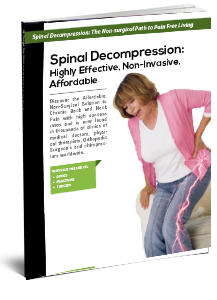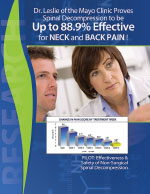Research Shows Spinal Decompression’s Effectiveness
What is the success rate of spinal decompression?
Most research has shown spinal decompression to be successful in 71% to 89% of patients. More than 10 different research studies have been conducted with all of them showing good results for patients treated with spinal decompression. Here is a summary of some of the research studies performed on spinal decompression.
At the 18th Annual Meeting American Academy of Pain Management, Tampa Fl Sept. 5 2007, John Leslie of the Mayo Clinic found the following:
- Multi-center, phase II, non-randomized pilot study utilizing spinal decompression
- Designed to evaluate the effectiveness and safety of spinal decompression in the treatment of chronic lower back pain
- Patients enrolled — average of ten years of chronic back pain
- After two weeks of treatments of spinal decompression — 50% reduction in pain scores
- Upon completion of the entire six week protocol success rate of 88.9% was documented
Can spinal decompression really cause a decrease in a disc herniation or cause an Increase In Disc Height
True non-surgical Spinal Decompression Therapy was developed to provide a non-invasive option for low back and neck pain caused by herniated, bulging and degenerated discs.
Researchers of a case report published in Volume 2 Issue 1 of the European Musculoskeletal Review state, “Evidence based data that show the promising effects of spinal decompression on the safe and effective treatment of LBP continue to accumulate. The report titled Management of Low Back Pain with a Non-surgical Decompression System Case Report reveals the pre and post treatment MRI findings of a 69 year old male with low back pain. Prior to treatment the patient reported experiencing low back pain radiating into both legs. When asked to describe his pain intensity on a scale of 0-10 the patient rated his pain a 10. The patient underwent 22 treatments over a seven week period. Utilizing the same pain intensity scale the patient reported a pain level of 1 post treatment. Four month after the initial treatment a follow up MRI revealed decreased herniation size and increased disc height at multiple lumbar levels.”
American Journal of Pain Management studied the Long-term Effect Analysis of Spinal Decompression Therapy in Low Back Pain: It was A Retrospective Clinical Pilot Study done in July 2005 by C. Norman Shealy, MD, PhD; Nirman Koladia, MD and Merrill M. Wesemann, MD. They observed the following Outcome: Of 24 study participants, each reported consistent pain relief and continual improvement of symptoms one year later. Improvement in pain continued after the treatment sessions were completed.
In Practical Pain Management from Technology Review April 2005. Vol. 5, Issue 3. C. Norman Shealy, MD and PhD found that “spinal decompression treatment leads to satisfactory pain relief and improved quality of life in up to 88% of patients-many of whom have failed other “conventional” approaches. Based on the author’s review of recent study results, spinal decompression appears to be the current optimal recommendation for most lumbar pain syndromes.
In an article in the Journal of Neuroimaging entitled MRI Evidence of Nonsurgical, Mechanical Reduction, Rehydration and Repair of the Herniated Lumbar Disc from April 1998 Vol. 8, NO.2, Edward L. Eyerman, MD., found that spinal decompression resulted in the following: “ All but 3 of 20 patients reported significant pain relief and complete relief of weakness and immobility, when present. This study also shows a correlation between the improvement on the MRI and the reported improvement in pain.”
In an article from the Journal of Neurological Research entitled Vertebral Axial Decompression for Pain Association with Herniated or Degenerated Discs or Facet Syndrome from April 1998 Vol. 20, NO.3, E. Gose, PhD; W Naguszewski, MD; R. Naguszewski, MD., found the following from spinal decompression: “Pain, activity and mobility scores greatly improved for 71%of the 778 patients studied. The authors consider VAX-D’” to be a primary modality for low back pain due to lumbar herniations, degenerative disc disease, and facet arthropathy. The authors concluded that post-surgical patients with persistent pain or “Failed Back Syndrome” should try VAX-D before further surgery.
Does the success of spinal decompression treatments last or does the pain just come right back when a patient is done with treatments?
“Results have been reported in a small series of patients with chronic low back pain caused by disc herniations, bulges and degeneration who were treated with a spinal decompression device. 4 years after receiving spinal decompression treatments, of the 23 patients who responded, 52% had a pain level of zero and 91% were able to resume their normal daily activities. Over 80% showed 50% or Better Pain Reduction at the End of the 4 Year study. And greater than 50% Still Had a Pain Level of Zero. Thus pain relief not only improved but lasted.”
~ Decompression Reduces Chronic Back Pain: A four year Study; R. Odell M.D., D Boudreau D.O., Anesthesiology News March 2003


Free Reports
Discover How Spinal Decompression is Changing the Way Neck and Back Pain Have Been Treated without Drugs, Pills, Shots, or Surgery.
How Do I Know If I am Eligible For Care?
Call Us Today to Schedule YOUR Consultation!
(925) 858-6844
We treat low back pain, neck pain, sciatica, herniated discs, degenerative or bulging discs, or spinal stenosis with non surgical spinal decompression. Learn more about this safe, comfortable, and affordable low back and neck pain treatment offered by Total Wellness Center in Pleasanton, California; read testimonials and spinal decompression reviews from many satisfied patients.
Call us to schedule a complimentary consultation to determine if you are a candidate for Spinal Decompression and our multi-step Protocol. The doctor will ask you a series of questions such as “Where is the pain, when did it begin, what makes it better or worse?” Then a thorough examination will be performed in which case the doctor will check your reflexes, blood pressure, balance, gait, skin sensory changes muscle strength and more to determine the cause of your back or neck pain. At this point the doctor may recommend x-rays or an MRI if he feels like further imaging will be necessary to determine the exact cause. After combining all of this information together the doctor will determine if you will make a good candidate for spinal decompression therapy and our multi-step Protocol. If you do qualify for care, your Doctor will explain their recommended plan of action for you. If for some reason you do not qualify for care the doctor will refer you to someone who may better suit your needs.
The information on this site has not been evaluated by the FDA.






